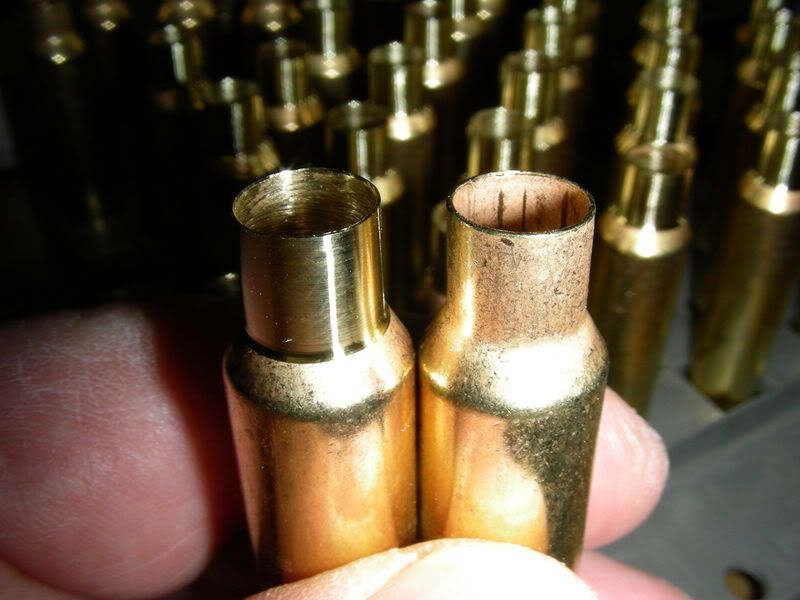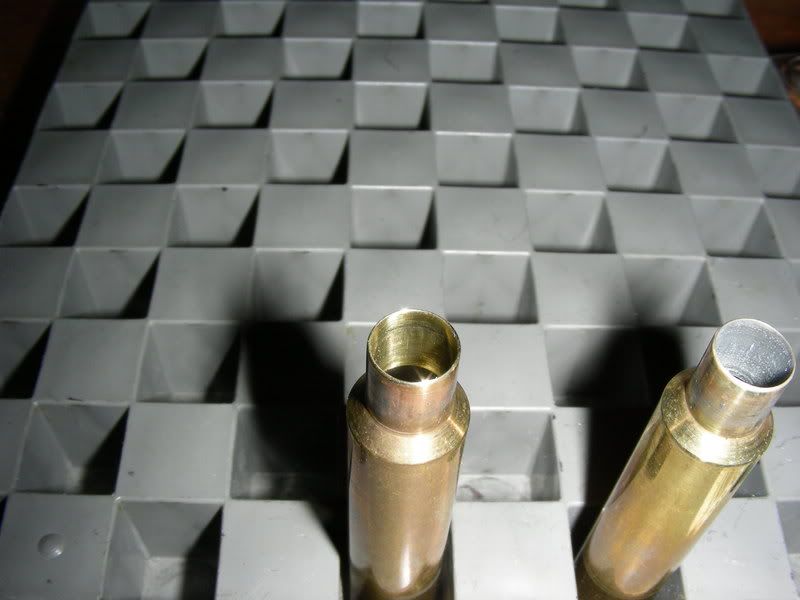

 The Accurate Reloading Forums
The Accurate Reloading Forums  THE ACCURATE RELOADING.COM FORUMS
THE ACCURATE RELOADING.COM FORUMS  Guns, Politics, Gunsmithing & Reloading
Guns, Politics, Gunsmithing & Reloading  Reloading
Reloading  How Much Does Case Neck Tension Affect Flight?
How Much Does Case Neck Tension Affect Flight?Go  | New  | Find  | Notify  | Tools  | Reply  |  |
| One of Us |
Is consistent case neck tension more important than the amount of case neck tension on the bullet? (Saving bullet setback due to little to no tension.) I just started neck turning for .308 and purchased a bushing type sizer die for the .308 with a variety of bushings. I was wondering if it would be worth purchasing the same type of sizer die for the .223 and also start turning case necks for it as well? What started this was my mic'ing of a variety of loaded rounds necks to determine the dia. of bushings I would need. I then did the same for .223. In .223 I have Lapua, Winchester, Federal, and Sellier n Belloit brass. While each one seems to be pretty consistent...the outside dia. of the neck of loaded rounds is a bit different between the brass makers...as much as .002. I didn't know if this was brass thickness or a function of the sizer die and truthfully which dia. bushings I should purchase for .223. OR if I should neck turn to make it all consistent! ARGGH! I hope I explained it well enuff. LOL! 'I pledge allegiance to the flag of the United States of America and to the republic for which it stands, one nation under God, indivisable, with liberty and justice for all.' | ||
|
one of us |
CONSISTENT case neck tension on the bullet and in the chamber neck are one of, if not THE most important factors in repeatable accuracy, imo.
You MUST have adequate tension on the bullet in order to keep the primer from blowing back against the bolt face. I have found that some makes of sizing dies reduce OD only .001 less than a loaded round if you use the expander.
If you do not mind the extra work, it is worth it, especially if you rifle chambers are tight necked. The variance of .002 can be a function of brass thickness and springback just after sizing. I would use a bushing that will neck size a particular brand of brass to .002 or .003 less than the measurement of the loaded round if that is an option. I would not try to uniform all of the brass to one OD since they are different brands. You can get into trouble if you make some necks too thin. Ted Kennedy's car has killed more people than my guns | |||
|
| One of Us |
It would seem by eliminating some of the brass I have and go with a couple brands...like Lapua and Winchester...I will help ensure I have consistent case neck tension across the board after I size the brass. Thanks.... 'I pledge allegiance to the flag of the United States of America and to the republic for which it stands, one nation under God, indivisable, with liberty and justice for all.' | |||
|
| one of us |
If you are willing to go to the trouble of neck turning (questionable benefits in a factory chamber), then surely you are not working with multiple brands of brass, or even multiple lots?? If yes, then you are likely pissing into the wind. If you decide to neck turn, IMHO you *have* to settle on ONE brand of brass, *and* keep lots separate. And yes, varying neck tension is a factor in accuracy. Anneal your brass when it has been fired X (fill in X as appropriate - often 5 is used) times, otherwise you'll experience varying neck tension all the same. Every gun/load seems to be law upon itself. Some like little neck tension, some like quite a bit. Only way to find out: experiment! - mike ********************* The rifle is a noble weapon... It entices its bearer into primeval forests, into mountains and deserts untenanted by man. - Horace Kephart | |||
|
One of Us |
Hey Renegade Turning will definitely help with bullet release consistancy. Especially if you are using the Redding Bushing Die without the expander. Without the expander the inconsistancies in brass thickness will be pushed to the inside of the neck. Seating the bullet will push those back but there will be different grip on the bullet inside the neck. Also it will help with bullet release if you clean and polish the inside of the neck to get rid of scratches and burrs, either from neck turning or chamferring  I clean and polish the inside of the necks with steel wool wrapped around a 22 caliber brush  I can tell the difference when seating bullets by the force it takes. You can also use a Lee Factory Crimp Die which has lowered the standard deviation of the velocity on a string of shots in my tests. ____________________________________ There are those who would misteach us that to stick in a rut is consistency - and a virtue, and that to climb out of the rut is inconsistency - and a vice. - Mark Twain | Chinese Proverb: When someone shares something of value with you and you benefit from it, you have a moral obligation to share it with others. ___________________________________ | |||
|
| One of Us |
I have quite a couple hundred never fired Winchester brass plus a couple hundred never fired Lapua .223 Match....but I will eliminate the other stuff. I can always plink with it or give it up or trade to a friend. I guess now I need to decide which size bushings I need to purchase. I found what I think is a couple good loads, but since I only have access to short ranges at present to practice on I wanted to try to eliminate as much 'other' influence as possible. And while I do have time? I am more anal about things than one person should be. LOL! I do appreciate all your help. 'I pledge allegiance to the flag of the United States of America and to the republic for which it stands, one nation under God, indivisable, with liberty and justice for all.' | |||
|
One of Us |
In my 'quest' for consistant neck tension - actually, just for the sake of playing around - I decided to have zero neck tension. I seat the bullets using paper hand towel then 'glue the bullet in with molten lube/wax mixture. (It is supposed to eliminate bullet runout and guide the bullet, straight, into the throat in a standard chamber). It does change pressure (reduces it) but group sizes remain the same or are at least a bit better. This is fine for a long necked hornet with 'zero' recoil but I am yet to test the 303 with a loaded magazine for bullet shift. Neck 'tension' is not zero. One can feel the resistance when 'pulling' the bullet. I also seat the 303 bullet as close to the base of the neck as feasable. P.S. This is a slow loading process but it does eliminate case or neck sizing and may be a bit faster than neck turning? But it is fun! (It also allows me to headspace the hornet on the case mouth!) Regards 303Guy | |||
|
| Powered by Social Strata |
| Please Wait. Your request is being processed... |
|
 The Accurate Reloading Forums
The Accurate Reloading Forums  THE ACCURATE RELOADING.COM FORUMS
THE ACCURATE RELOADING.COM FORUMS  Guns, Politics, Gunsmithing & Reloading
Guns, Politics, Gunsmithing & Reloading  Reloading
Reloading  How Much Does Case Neck Tension Affect Flight?
How Much Does Case Neck Tension Affect Flight?

Visit our on-line store for AR Memorabilia

